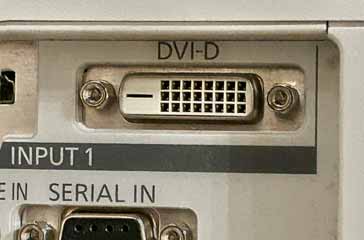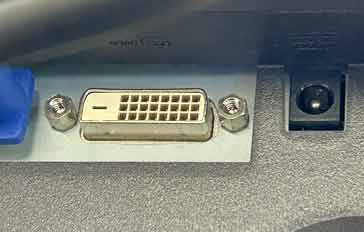What is DVI - Digital Visual Interface
DVI or Digital Visual Interface is a standard that is used on many older computers and monitors enabling either analogue and digital standards to be used.
DVI Digital Visual Interface Includes:
DVI - the basics
The letters DVI stands for Digital Visual Interface (sometimes also referred to as Digital Video Interface) and it is a standard that was developed for transmitting digital video content to display devices.
DVI is found on many older computers and it is often seen on many devices including computer monitors, projectors as well as some televisions and other display devices.

Although the standard is relatively old now, it is capable of handling resolution levels as high as 2560 x 1600 at 60 Hz, although the HD standard of 1920 x 1080 was far more widely used.
Despite its name, DVI, Digital Visual Interface is the only video interface that incorporates both analogue and digital capabilities with some cables being able to carry both standards.
DVI is an open industry standard and it was introduced to provide a higher level of performance than was available at the time as well as accommodating one of the core issues of time which was in replacing legacy analog technology with digital technology and maintaining a link with both.
DVI introduction
The DVI standard was developed by the Digital Display Working Group, and it was first introduced in April 1999.
It superseded the VGA standard and associated connector, but provided a very useful development as the industry moved from fully analogue displays to digital ones.
DVI versions were able to handle both digital and analogue signals, provided that both ends of the link could handle them and as such provided an ideal stepping sone.
Nowadays, standards like DisplayPort and HDMI have overtaken DVI and it is not normally introduced into new products.
DVI basics
The main function of DVI is to provide a digital video interface, although analogue capability was added to provide compatibility with older analogue equipment which was still in widespread use at its inception.
There are three 'types' of DVI that can be used:
DVI-A: This is the analogue only version of the DVI standard and it only supports the analogue signals, and the connector is populated accordingly.
DVI-D: As expected, this is the digital only version of the standard, and again, not all the possible connections are populated.
DVI-I: This abbreviation stands for DVI Integrated and it supports both analogue and digital signal formats.
The DVI digital video interface utilises a panelLink serial data format that was originally developed by a company called Silicon Image. Its digital video transmission is on transition-minimized differential signaling.
This is based around a high speed serial link format referred to as Transition Minimized Differential Signalling, TMDS. This transports the data over multiple twisted pair wires, and the connections for these can be seen in the connector pinouts below. The use of twisted pair wires provides a good level of immunity to radiation and stray pickup, making the connections much more resilient.
The data is formatted using 8b/10b encoding. It is also transmitted as a form of rasterised data, i.e. effectively as a form of digitised analogue signal - the analogue signals scanned each line and then returned to the beginning of the next because of the way signals needed to be presented to a cathode ray tube.
When the source and the sink (display unit) are connected, the source will query the display capability from the display. It shares the display identification data which includes parameters such as the Gamma value, colour characteristics, and list of supported video modes, native resolution, and designated preferred mode.
Each mode has a set of CRT timing values to enable horizontal and vertical synchronization, as well as aspects including the vertical and horizontal resolution, active display area, and the refresh rates.

In view of this a complete frame is carried during each vertical refresh period, and the data for the active area of each frame is not compressed.
In view of the compatibility requirements for cathode ray tubes, the video modes normally use horizontal and vertical refresh timings that are compatible with cathode-ray tube operation.
There are two levels of digital interface that can be used with DVI: what are termed single link and dual link.
• Single link
Single link is the basic level of link for DVI-D. This has four TDMS pairs for data transmission. Three of these data pairs carry 8 bit RGB, red, green, blue components of the signal and the fourth essentially carries the clock data.
The maximum clock frequency is 165 MHz, and this means that the maximum resolution is 2.75 megapixels and this includes the blanking interval and at 60 Hz refresh rate.
• Dual link
Dual link is used to support higher resolution displays. Dual link DVI doubles the number of data pairs and this can be seen int he connector pinouts shown below.
Dual link DVI-D increases the maximum resolution achievable to 2560 × 1600 at 60 Hz or higher refresh rates for lower resolution levels.
DVI cable lengths
Cable lengths are not defined in the DVI standard, but it is generally recognised that the maximum usable length for a 1920x1080 HD signal is about 4.5 metres.
Longer lengths can be used for lower resolution signals, for example 15 metres is accepted as the maximum for 1280x1024.
The governing factor for these maximums is the TMDS clock frequency required.
If greater lengths are required, then a DVI signal booster or repeater should be used to clean up the signal and give the required extended length. If this is not done, then the display resolution may decrease or data errors be introduced.
It is also wise to select a good quality cable of the right length as this will ensure the optimum performance.
DVI connectors & pinout
The connectors used for DVI ports are quite distinctive and they are low-force helix types. The DVI connectors have a maximum of 24 pins in the order of the three-row matrix for what may be termed the main digital area of the connector. In addition to this, there are four additional pins that are present on analogue, or analogue compatible connectors. In addition to the standard size connector, mini and micro versions were also available, but they are rarely seen, especially these days.
Although the outline is the same, there are different versions of DVI connector that are available according to the loading and the capability of the port.
A view of te overall layout is given below, and then the individual versions:

The connector with all the signal lines and connections present will support dual link (and single link) digital operation as well as analogue operation.
There is also a variety of different variants of the connectors apart from this resulting that only support limited options. These are outlined below.
DVI-A analogue only

This option is for situations where only analogue content is required. It contains the least populated form of connector, although a number of the lines in the main section of the connector are required as shown.
DVI-D single link

This is the least populated of the DVI-D digital connectors as it only supports single link operation. The connections of the first link are present, but the second link and analogue connections are not required and hence not present.
DVI-D dual link

This set of connections is able to support digital dual link operation- it can be seen that connections for data links 1 and 2 are present.
DVI-I single link

This configuration provides for both analogue and digital operation, but only using single link as there are only the connections for data link 1.
DVI-I dual link

This is the most 'fully-loaded' form of connector supporting both analogue and the dual link digital formats to provide all formats and at the highest resolution for digital.
DVI is now an obsolete standard which is not now being incorporated on new electronics and computer equipment. However it can still be found on many older monitors, screens, projectors and the like.
It served its purpose well during the time when many computers were cathode ray tube, CRT based and there was a switch over from analogue to digital. Also the basic operation of CRT monitors used scanning techniques to scn individual lines each in trun down the screen. The DVI data format accommodated this very we.
Although a number of screens and projectors may still use this, as technology moves on , these will become less common.
More Audio Video Topics:
HDMI
SCART
DisplayPort
DVI
Loudspeaker technology
Headphones & earphones
Bluetooth speakers
Stereo sound
Microphones
Audio compact cassettes
Vinyl record technology
Digital radio
DVB television
Return to Audio / Video menu . . .


